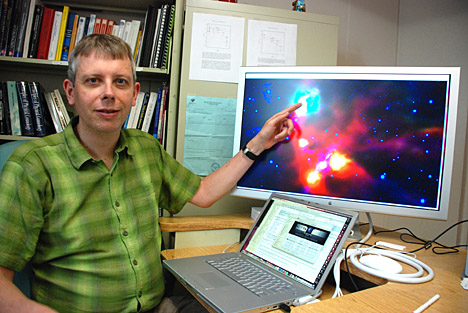An unexpected discovery found with Herschel Space Observatory data has received international attention, and a UT researcher is behind the buzz-worthy research.

Dr. Tom Megeath pointed to NGC 1999, the green cloud in this image taken by Herschel, the European Space Agency’s far-infrared telescope. The dark spot to the right was thought to be a cloud of dust and gas, but Megeath discovered it is a hole blown in the side of NGC 1999 by the narrow jets of gas from young stars.
Astronomers had seen this black patch in a nursery of young stars before, but the Herschel data combined with that of telescopes confirmed there is really nothing there. This hole seems to be created when the narrow jets of gas from young stars nearby break through the dust and gas of the cloud.
“Part of the study of star formation is what stops star formation, and we just got a better glimpse of how that happens,” said Dr. Tom Megeath, UT associate professor of astronomy, who is the principal investigator on the “Herschel Orion Protostar Survey” research project. “This is just a teaser. We’re going to be up to our eyeballs in data from Herschel and there will be much more to come.”
The European Space Agency and NASA, which is a partner in the Herschel project, released news of this unexpected discovery last week and it was quickly picked up by National Geographic, national CBS and Fox news organizations, and a number of international news and blog websites.
Megeath said he “never would have predicted this level of interest” and is glad to be a part of such a worthwhile research project.
This piece of datum on the unexpected hole is just one part of Megeath’s research into star formation in the Orion constellation using the Herschel telescope to delve into the “cold universe” and get the best view yet of stars enshrouded in dust.
Information gained from Megeath’s project and his 200 hours with the Herschel telescope will give insight to the origin of our own sun and why our solar system formed the way it did. And as one of the key projects for Herschel, his findings is likely to create a foundation that will impact the future of astronomy.